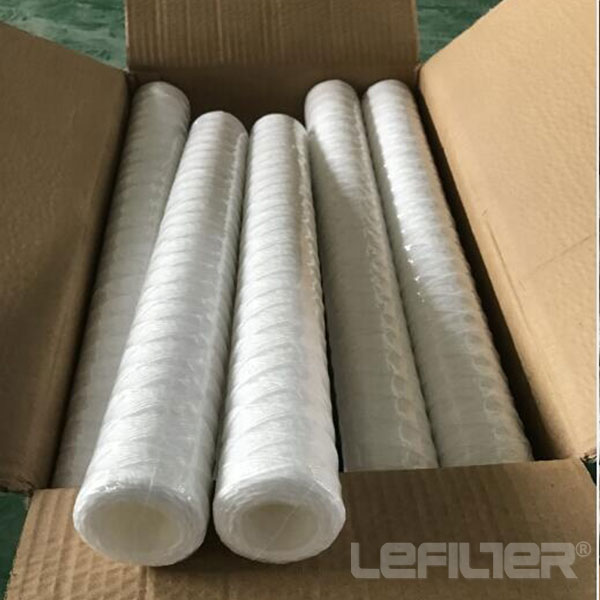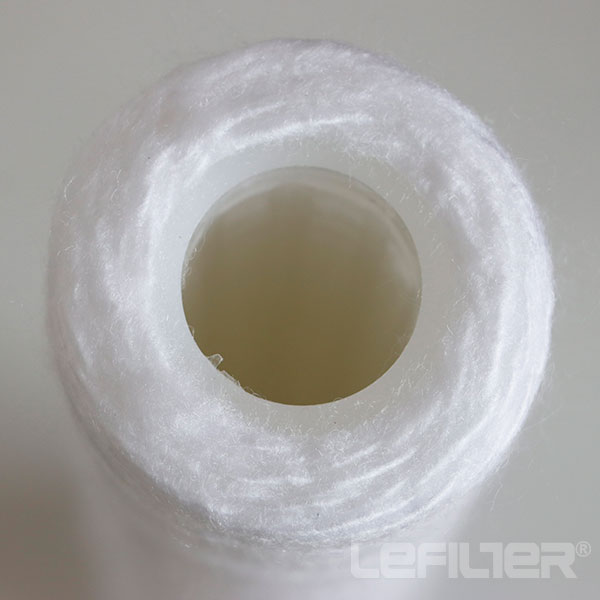What is wire wound filter?
Wire-wound cartridge is a kind of deep filtering core, used for low viscosity and low miscellaneous quality filtration, which is made of textile fibre yarn (polypropylene yarn, skimmed cotton yarn, etc.), precisely wound on top of porous skeleton (polypropylene or stainless steel) according to a specific process, with a honeycomb structure of sparse outside and dense inside, which can effectively remove suspended matter, particles, rust and other debris in the fluid, and has very excellent filtration characteristics.

A wire wound filter is a type of water filter that is designed to remove sediment and particulate matter from a fluid. It is made by winding a wire, typically made of polypropylene or stainless steel, around a cylindrical core, forming a deep filtration layer. This winding pattern forms a diamond-shaped network, and the overlap area becomes the filter area.
The wire wound filter operates by trapping and holding particles in its winding maze while allowing the fluid to flow through. The size and shape of the filter's pores can be precisely controlled, which allows the filter to capture particles of a specific size. This makes it highly effective for applications where precise filtration is necessary.
The wire wound design also allows for a high dirt-holding capacity, meaning the filter can trap a significant amount of particles before it needs to be replaced. This makes them an economical choice for many applications, especially where large volumes of liquids need to be filtered.
What is the working principle of the wire wound cartridge?
Wire-wound cartridges are crafted by intricately winding textile fibres onto a multi-structured skeleton in a very specific pattern. The precision of filtration can be adjusted by controlling the density of the winding process during the creation of these cartridges. This means that cartridges with varying filtration preciseness can be produced to meet different requirements, making them highly versatile.
One of the most distinctive features of these cartridges is their pore size gradient. The outer layer of the cartridge has larger pore sizes compared to the inner layer which has smaller pore sizes. This design is intentional as it facilitates an excellent deep filtration effect.
As water or any liquid passes through the cartridge, larger particles are trapped in the outer layers while smaller particles are captured in the inner layers. This progressive filtering mechanism enables the wire-wound cartridges to effectively filter out impurities of different sizes at various depths, thus enhancing the overall filtration efficiency.
What is the product advantadges of the wire wound cartridges?
Wire-wound cartridges are known for their high filtration precision. They boast an over 90% retention rate relative to filtration accuracy. The cartridges offer a wide range of filtration precision, making them suitable for various application requirements. They possess excellent dirt retention capabilities and have a long service life, which makes them both efficient and cost-effective.
These cartridges are designed with a large filtration area. The membrane is folded deeply, providing a substantial surface area for filtration. This design enhances the cartridge's ability to filter out impurities, contributing to its overall efficiency.
One of the standout features of these cartridges is their internal thread construction, which enhances their resistance to pressure. They offer wide chemical compatibility, high flow capacity, and low differential pressure. They are washable and regenerable, offering further economic advantages. Moreover, they can be sterilised using chemical methods or in-line steam, ensuring their hygiene and safety.
Wire-wound cartridges are made from food-grade materials, making them safe for various applications, including those in the food and beverage industry. The filter media is made of polypropylene fibre membrane, while the upper and lower flow support material, support frame, and structural elements are all made from polypropylene. The sealing materials used include silicone rubber, nitrile rubber, EPDM rubber, and fluoroelastomer.
The cartridge's structure is designed to be sparse on the outside and dense on the inside, resembling a honeycomb. This unique structure enables high dirt-holding capacity, allowing the cartridge to trap and retain a substantial amount of impurities before needing to be replaced or cleaned. This makes the wire-wound cartridge an effective and reliable choice for diverse filtration needs.

The technical parameters of wire wound filter element
This cartridge comes in varied lengths, making it adaptable to different devices and systems. The lengths available are 10″, 20″, 30″, and 40″. It has a specific outer diameter of Φ60mm or Φ65mm and an inner diameter of Φ28mm or Φ30mm, ensuring precise fitting in different systems.
The cartridge is designed to withstand considerable pressure. It has a maximum pressure drop of 0.2MPa and can resist pressures up to 0.5MPa. This durability ensures reliable performance even under challenging conditions.
The filtration material used in the cartridge includes polypropylene PP line, skimmed cotton line, and glass fibre line. This allows it to offer a wide range of filtration precision, from 1μm to 100μm, catering to various filtration requirements.
The central skeleton of the cartridge is built with either a polypropylene PP skeleton or a stainless steel skeleton, further enhancing its durability and functionality.
The maximum working temperature for this cartridge varies depending on its construction. For a cartridge made with a polypropylene thread and a polypropylene skeleton, the maximum working temperature is ≤ 60℃. For a cartridge with a stainless steel skeleton, the maximum working temperature is ≤ 80℃. For a cartridge made with a skimmed cotton thread and a stainless steel skeleton, the maximum working temperature is ≤120℃.
The wire wound filter element plays a crucial role in water treatment systems for several reasons:
High Filtration Precision: Wire wound filter elements can trap particles of various sizes, thanks to their unique construction. They offer high filtration precision which is essential in water treatment to remove impurities and ensure the water is safe for use.
Durability: These filters are designed to withstand substantial pressure and temperature variations, making them suitable for rigorous water treatment processes. They are also resistant to various chemicals, adding to their durability.
Versatility: Wire wound filters can be made with different materials and specifications, allowing them to be customized to fit the specific needs of a water treatment system. This flexibility makes them suitable for a wide range of applications.
High Dirt-Holding Capacity: Thanks to their unique design, wire wound filters have a high dirt-holding capacity. This means they can trap a significant amount of impurities before needing to be replaced, making them cost-effective.
Deep Filtration: The design of the wire wound filter allows for deep filtration, capturing impurities throughout the depth of the filter rather than just on the surface. This results in more effective filtration and cleaner output water.
Reliability: Wire wound filters are known for their reliability. They consistently deliver high-quality performance, ensuring the filtration process is effective and efficient.
In summary, wire wound filter elements are an integral part of water treatment systems due to their precision, durability, versatility, high dirt-holding capacity, deep filtration capabilities, and reliability. They ensure that the water is thoroughly purified, making it safe for various uses.







